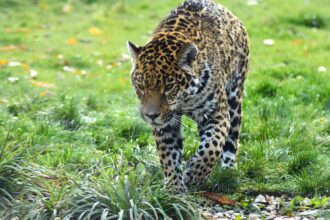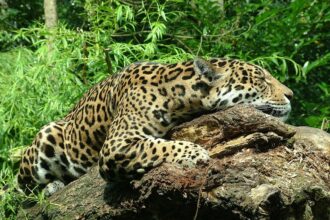Collaborative Efforts in Jaguar Conservation: NGOs and Government Initiatives in Mexico
Understanding the Jaguar’s Importance
Jaguars (Panthera onca) are apex predators essential to maintaining the ecological balance in their habitats. As keystone species, they regulate the populations of other wildlife, affecting entire ecosystems. However, habitat loss, deforestation, poaching, and human-wildlife conflict have led to their classification as Near Threatened by the International Union for Conservation of Nature (IUCN). In Mexico, the jaguar’s population has dwindled due to these anthropogenic pressures, prompting urgent conservation actions.
The Role of NGOs in Jaguar Conservation
Non-governmental organizations (NGOs) play a pivotal role in jaguar conservation efforts across Mexico. They work in collaboration with local communities, government agencies, and international partners to implement effective conservation strategies. Some prominent NGOs include the World Wildlife Fund (WWF), Panthera, and Conservation International. Each organization contributes to jaguar conservation through various means, from research and advocacy to on-the-ground conservation programs.
1. Research and Monitoring
Research is vital for understanding jaguar behavior, habitat requirements, and population dynamics. NGOs such as Panthera have invested significantly in field studies, employing cutting-edge technologies like camera traps and GPS collaring to monitor jaguar populations. This data helps in identifying key habitats that need protection, understanding migration patterns, and assessing threats faced by jaguars. It also informs conservation strategies and policies.
2. Community Engagement
Effective conservation involves local communities, who often coexist with these majestic cats. NGOs focus on engaging indigenous and rural populations in conservation efforts. By educating communities about the ecological importance of jaguars, organizations like WWF and Conservation International work to reduce local fears and misconceptions surrounding these predators. Initiatives include training locals in sustainable land-use practices and developing eco-tourism ventures that provide economic incentives for protecting wildlife.
3. Habitat Protection and Restoration
To curb habitat loss, NGOs collaborate with government entities to establish protected areas for jaguars. Important regions such as the Selva Maya and the Maya Forest have seen concerted efforts to secure legal protections, limiting industrial activities and deforestation. Restoration projects aim to recover degraded habitats. Reforestation of native flora and the creation of wildlife corridors facilitate jaguar movement, ensuring genetic diversity and reducing human-wildlife conflict.
4. Anti-Poaching Measures
Poaching remains a significant threat to jaguar populations. NGOs work alongside government forces to combat illegal hunting and trafficking. They implement patrols in critical habitats, raise awareness about wildlife crime, and support stronger legal frameworks to penalize poachers. Community-based programs empower locals to take part in monitoring wildlife, fostering stewardship while creating alternate livelihoods that do not rely on poaching.
Government Initiatives in Jaguar Conservation
The Mexican government recognizes the importance of conserving the jaguar, leading to the formulation of national policies and action plans. Initiatives such as the National Jaguar Recovery Strategy aim to enhance conservation efforts through multi-sectoral collaborations, combining the resources of federal, state, and local governments. This is crucial in addressing the multi-faceted challenges of jaguar conservation.
1. Legal Frameworks
Mexico’s legal framework includes several laws and programs aimed at biodiversity conservation. The General Law of Ecological Equilibrium and the Protection of the Environment establishes guidelines for the protection of species like the jaguar. The government has ratified international treaties, such as the Convention on Biological Diversity, reinforcing its commitment to global conservation standards.
2. National Parks and Biosphere Reserves
National parks, like the Sierra del Abra Tanchipa and Calakmul Biosphere Reserve, are homes to thriving jaguar populations. These protected areas not only safeguard habitat but also serve as essential research sites for biologists studying the species. Government partnerships with NGOs ensure that these regions receive adequate funding and management, making them bastions of biodiversity.
3. Training and Capacity Building
The Mexican government offers training programs for rangers and enforcement personnel to enhance their skills in wildlife protection. Workshops on conservation ethics and effective patrolling methods, delivered through partnerships with NGOs, ensure that local authorities are equipped to combat threats facing elephants. This capacity building fortifies the front lines of conservation efforts.
4. Indigenous Land Rights and Participation
Acknowledging the integral role of indigenous communities, governmental policies encourage the self-determination of these groups in conservation initiatives. Programs which promote traditional ecological knowledge and sustainable practices allow for the incorporation of cultural values into modern conservation strategies, ensuring that the interests of indigenous populations coincide with those of jaguar protection.
Case Studies: Successful Collaborative Projects
Several programs highlight successful collaborations between NGOs and the government. The “Jaguar Project” in the Yucatán Peninsula exemplifies this synergy. Here, WWF, local communities, and government agencies worked together to establish wildlife corridors, enhancing genetic connectivity among jaguar populations. The project employed innovative measures, like community-managed ecotourism, to provide alternative income sources while fostering conservation.
The “Jaguar Conservation Workshop” convened by Panthera brought together stakeholders across multiple sectors, from academia to government officials, to discuss best practices and foster collaboration. The resultant action plans have influenced local policies and strengthened partnerships on conservation initiatives.
Challenges Ahead
Despite significant advances, obstacles remain. Limited governmental budgets and prioritization of economic development over conservation pose considerable challenges. Moreover, the complex socio-political landscape in Mexico can hinder effective collaboration across different levels. Climate change further threatens jaguar habitats, necessitating a proactive approach to enhance resilience.
Innovative Futures
Looking ahead, innovative conservation strategies utilizing technology will likely play a crucial role. Initiatives leveraging artificial intelligence for data interpretation can accelerate research efforts, while social media campaigns can spread awareness and generate support. Enhancing cross-border collaboration with neighboring countries will also allow for a more comprehensive regional approach to jaguar conservation.
Final Thoughts: A Collaborative Path Forward
The continued survival of the jaguar in Mexico relies heavily on collaborative efforts between NGOs and governmental entities. Through robust research, community engagement, effective policy, and innovative conservation strategies, these partnerships are paving the way for a brighter future for jaguars and the ecosystems they inhabit.







